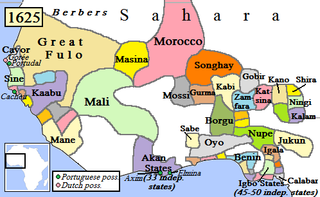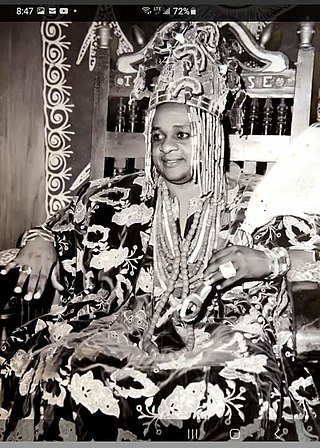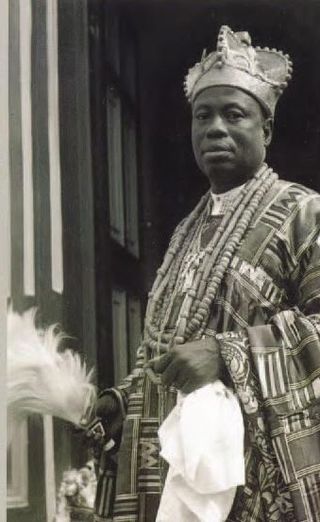| Part of a series on |
| Yorùbá people |
|---|
 |
Oyo, Oyo State, is the seat of the line of the rulers of Oyo. Their territory, a constituent rump state, is located in contemporary Nigeria. Since the 1900 political absorption into Southern Nigeria of the kingdom that it once served as a metropolitan center, the traditional monarchy has been either a tool of British indirect rule or a legally recognised traditional polity within the republic of Nigeria.
In the Yoruba language, the word 'oba' means ruler or king. It is also common for the rulers of the various Yoruba domains to have their own special titles. In Ọ̀yọ empire, the oba is referred to as the Aláàfin , meaning owner of the palace.
List of Alaafins of Oyo [1]
| Tenure | Incumbent | Notes |
|---|---|---|
| c.1300 | Foundation of Oyo Empire | |
| c. 1210 | Oranyan , Alaafin | grandson or some say son, of Oduduwa, founder of the second Ife dynasty and ancestor to most kings of Yorubaland. |
| c. 1242 | Ajaka , Alaafin | Succeeded his father, Oranyan. He was said to be a peaceful and calm king, unlike his father, and brother, and his peacefulness caused his more angry and powerful brother to take over and overthrow him. |
| c. 1252. | Shango , Alaafin | Another son of Oranyan, he was appointed by the Oyo Mesi after dethroning his brother, Ajaka, he reigned for 7 years, after which he became regarded as an orisha having been combined with Jakuta, an earlier orisha in Yoruba mythology |
| c. to c. | Ajaka (restored), Alaafin | Ajaka returned to the throne after the death of his brother. |
| c. 1277. | Aganjusola , Alaafin | Son of Ajaka who succeeded his father. He was said to have tamed many wild animals, and he reigned for an incredibly long time. He is synonymous with the Yoruba deity of the same name |
| c. 1340 | Kori , Alaafin | Succeeded his father, Aganju, who died while he was still a child. The early period of his reign was overseen by his mother, Iyayun as regent. He waged a war with the town of Ede. Under Alaafin Kori, the city of Oyo Ile expanded to include the region referred to as metropolitan Oyo. He is also regarded to have reigned over 50 years making him the longest reigning Alaafin. |
| c. 1401 | Oluaso , Alaafin | Succeeded his father, Kori. He was said to be handsome and had up to 1,460 children by his hundreds of wives. O ni ki ogbogbo Oluaso, O le je iya Oluaso – is a saying often interpreted as he living a long but challenging life |
| c. 1490 - c. 1542 | Onigbogi , Alaafin | Nupe expanded to occupy Oyo's capital, driving the Alaafin away from his capital in 1535. He fled to take refuge with the Borgu |
| c. 1542 | Ofiran,Alaafin | Crowned a King in exile after a period of regency by his Mother, Oba Adasobo. He is sometimes considered the 10th Alaafin when the regency of Iyayun and Adasobo are counted. He retook some of Oyo's original territory from the Nupe. |
| c. 1550 | Eguguojo , Alaafin | Created Igboho as new capital. |
| 1554 to 1562 | Orompoto , Alaafin | Sister of Eguguojo, and first break of the Father-Son succession pattern since Aganju succeeded Ajaka. Drove many Nupe away from Oyo in 1555. Continued to record victories throughout her reign. |
| 1562 - 1570 | Ajiboyede , Alaafin | Starts the First Bere festival under reign. |
| 1570 - 1588 | Abipa , Alaafin | Born 20 years after the Fall of Oyo-Ile. Rebuilt Oyo-ile back as capital after 80 years in 1615 |
| 1588 - 1599 | Obalokun , Alaafin | Europeans bringing salt arrive in Oyo during reign of Obalokun. Period of effective expansion. |
| ???? to ???? | Oluodo , Alaafin | |
| ???? to 1659 | Ajagbo , Alaafin | First Alaafin to wear the Sesefun crown. He also created the Aare Ona Kankanfo title |
| ???? to 1659 | Odarawu , Alaafin | |
| 1659 - 1665 | Kanran , Alaafin | He was killed during a mutiny of his army, after refusing to obey orders to commit suicide. |
| 1665 - 1676 | Jayin , Alaafin | Tyrant who was overthrown by Oyo mesi. |
| 1676 - 1690 | Ayibi , Alaafin | Olusi's son, who was a minor. Basorun ruled regent until he was of age. Then, he became tyrannical and was rejected by the Oyo mesi. |
| 1690 - 1692 | Osiyago , Alaafin | Assassinated. Found dead in an improper situation with a medicine man's wife. |
| c. 1724 to 1730 | Ojigi , Alaafin | He conquered the Dahomey Kingdom |
| c. 1730-1746 | Gberu , Alaafin | He conferred Basorun title to his friend, Jambu, out of fear of the existing Basorun's power. Jambu then engineered Gberu's rejection and ruled as regent, then committed suicide as well. |
| c.1746 | Amuniwaiye , Alaafin | Assassinated by a personal enemy |
| c. 1746 to 1754 | Onisile , Alaafin | He was rejected by the Oyo mesi. |
| July 1754 | Labisi , Alaafin | He never formally ruled, and was instead on the 17th day of his installation ceremony compelled to commit suicide by Bashorun Gaa |
| July 1754 to October 1754 | Awonbioju , Alaafin | He ruled for about 130 days, before being compelled to suicide by Bashorun Gaa |
| 1754 to c.1768 | Agboluaje , Alaafin | He was forced to commit suicide by Bashorun Gaa after refusing to declare war against the town of Ifonyin |
| c.1768 to c.1774 | Majeogbe , Alaafin | Brother of Agboluaje |
| c. 1774 to April 1789 | Abiodun , Alaafin | Defeated Bashorun Gaa with the support of Oyabi, the Aare Ona Kakanfo. The Egba got their independence during his reign |
| 1789 to 1796 | Awole Arogangan , Alaafin | Son of Agboluaje, he installed Afonja of Ilorin as Aare Ona Kakanfo, a distant relative to the Oyo royal family. He was overthrown by Afonja and his army where he committed suicide by poison. |
| 1796 to 1797 | Adebo , Alaafin | He ruled for about 130 days, he died likely by suicide or murder |
| 1797 | Makua , Alaafin | He ruled for only two months |
| 1797 to 1802 | vacant, vacant | The Bashorun Ashamu served as regent during this period |
| 1802 to 1831 | Majotu , Alaafin | Is said to have been quite old when he ascended the throne. During his reign Ilorin seceded from Oyo and in 1823 Dahomey under Ghezo got their independence |
| 1831 to 1833 | Amodo , Alaafin | Ilorin invaded in 1833 and sacked the palace after a long siege |
| 1833 to 1835 | Oluewu , Alaafin | the Fall of Oyo empire after the Eleduwe war. |
| 1837 to 1859 | Atiba Atobatele (at new capital), Alaafin | Son of Alaafin Abiodun. He maintained influence over cities like Ijaye and Ibadan by given titles to their leaders while continuing to call himself 'emperor' and maintained the claim to rule over Yoruba speaking areas even outside his influence. |
| 1859 to 1875 | Olujide Adelu Agunloye , Alaafin | Eldest son of Atiba. He was chosen by Atiba to ascend the throne after him. |
| 1876 to 12 November 1894 | Adeyemi I Alowolodu , Alaafin | A son of Atiba. He was the last independent Alaafin of Oyo. Signed Treaty with the British on July 3, 1888. On November 12, 1894, the town of New Oyo was bombarded and brought forcibly under British colonial rule. |
| 12 November 1894 to 1905 | Adeyemi I Alowolodu (as British Vassal), Oba | |
| 1905 to 1911 | Lamidi Amubieya Agogoja (as British Vassal), Oba | Eldest son of Alaafin Adelu |
| 1911 to 1944 | Siyanbola Onikepe Oladigbolu I (as British Vassal), Oba | Son of Agogoja |
| 1944 to 1945 | Regent (as British Vassal), Oba | |
| 1945 to 1955 | Adeyemi II Adeniran (as British Vassal), Oba | Son of Adeyemi I |
| 1955 to 1956 | Regent (as British Vassal), Oba | |
| 1956 to 1960 | Bello Gbadegesin Oladigbolu II (as British Vassal), Oba | Son of Alaafin Oladigbolu I |
| 1960 to 1968 | Bello Gbadegesin Oladigbolu II (as Nigerian Traditional Monarch), Oba | |
| 19 November 1970 to 22 April 2022 | Lamidi Olayiwola Adeyemi III (as Nigerian Traditional Monarch), Oba | |








